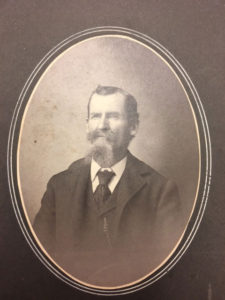Christine Maccabee
Many years ago, I found a holly tree that was half-dead in a pot at a nursery. They were closing up for the winter, so were only too happy to sell the holly to me at half the price. Thrilled, I brought it home and planted it with great care on one side of my house. Over the years, it grew nearly as high as the roof.
Several years ago, my holly got a disease and was obviously dying, so with great sorrow, I decided to have it cut down. However, I noticed a shoot coming up one side of the stump and decided to give it a chance. Now I have a lovely young tree, about ten feet tall. As you can see, I do not give up easily on living things.
Just last month, while sitting at my computer, I heard a commotion outside my window. It was a fluttering of wings, but mostly some loud screeching or calling. Looking out, I saw two blue jays, one of which was a juvenile. The older, larger adult was broadcasting a message out to the rest of his clan, I suppose, saying “No berries on this holly.” I have learned that birds have specific calls or songs for specific purposes, the truth of which reveals their amazing innate intelligence (which some call instinct). Indeed, sadly, even though those two blue jay scouts had found a holly tree, there were no berries on it because it is a male.
Some people do not like blue jays, especially not when they come to feast at their bird feeders. Jays have gained an unfair reputation as bullies, even bandits, due to the mask patterns around their eyes and an occasional nest robbery. In fact, blue jays are related to crows and ravens, which are known to be carnivorous, but rarely eating the eggs of other birds. J.J. Audubon called his drawing of blue jays “Crested Crows,” which is a translation from the Latin. They will even eat your cat’s food and pluck out the eyes of dead animals. Some people call them “winged vagabonds.” Call them what you like; I think they are beautiful.
According to naturalist Calvin Simonds, the blue jay’s reputation as a nest robber is “much overstated,” as they prefer nuts, acorns, seeds, and small fruits.1 In fact, the blue jay is actually a tropical bird, which has expanded its range through North America, as far north as Maine. Talk about adaptation of a species! I admire the blue jay for its pluck. As for the “bully at the bird feeder” accusation, I believe smaller birds are simply intimidated by the blue jay’s large size. I have never seen a blue jay bully my smaller birds, although some animals—as well as some human beings—seem to exhibit inbred, bullying tendencies.
After the disappointment expressed by my two jays in the holly tree, I decided I need more hollies, female ones this time, to get berries for all my birds. I already have dogwoods on my land, but not nearly enough native elder, cherry, crab apple, or holly. Red cedar is a good tree for wild fruit, but is known to create disease in your orchard trees if it is within one mile of them. However, on Cape Cod, a birder counted 20,000 migrating robins in a cedar tree grove, eating their fill until finally leaving to go further south, so cedar is a great habitat in the right places.
But, I digress…now back to the holly. I emailed a naturalist friend, who has a stand of female holly trees. Before winter is out, I will be rooting as many cuttings from his hollies as I am able, so, in time, I will have plenty of wild fruit to help my frugivore-feathered friends through the winter. So, what’s a frugivore, you ask?
In my research, I learned that some birds are frugivores, or fruit lovers. Besides blue jays, other frugivores are robins, bluebirds, thrush, mockingbirds, catbirds, and cedar waxwings, along with others, I am sure. Developing habitat for wild birds and bees and insects of all sorts requires appropriate and diverse vegetation. So, I must thank my blue jays on the holly outside my window for spurring me on to a better wildlife management plan. Seeds in my feeder and suet are not the only ways I can help my kin.
I do not care as much about the ornamental qualities of hollies and dogwoods, but more about their usefulness for wildlife. After all, what would this world be like without the voices of the birds, the buzzing of the bees (all wild fruiting trees get flowers first), the astounding colors of flowers, and the voice of the wind through the trees, even my poor little male holly tree; perhaps it will be thrilled to have a few females around!


